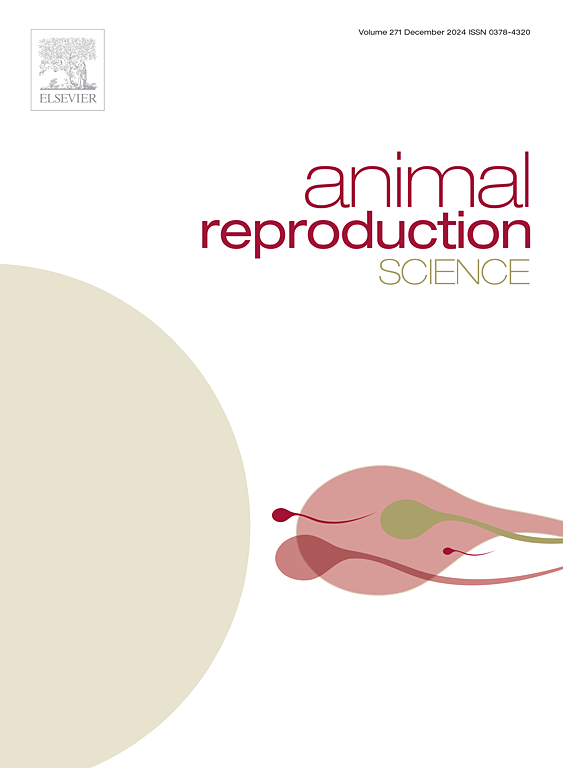Bovine β-defensin 129 (BBD129) polymorphisms associated with differential posttranslational O-glycosylation and phosphorylation modifications perturb the sperm functions and their fertilizing potential
IF 3.3
2区 农林科学
Q1 AGRICULTURE, DAIRY & ANIMAL SCIENCE
引用次数: 0
Abstract
In our earlier finding BBD129 polymorphisms were differentially distributed in the distinct fertility cattle bulls and associated with altered post-translational modifications (PTMs), and sperm function. This study investigated the relationship between in-silico analysis of BBD129 polymorphism and previously used high-fertility (HF) and low-fertility (LF) cattle bulls’ sperm. Using CFDA-PI staining, it depicted similar frozen viable, moribund, and non-viable sperm population profiles between the HF and LF cattle bulls. Phosphorylation quantification via microscopy and flow cytometry revealed significantly higher serine and threonine phosphorylation in LF sperm, particularly in the tail and head regions, aligning with in-silico predictions and suggesting a link to LF bulls. Glycan localization was assessed using a panel of seven lectins, revealing distinct surface glycan patterns between HF and LF sperm. Lectins targeting O-linked glycans (MAL-II, Jacalin, SNA) showed significantly higher binding on HF sperm surface, whereas LCA and PNA were more abundant on LF sperm. These findings were consistently confirmed by both microscopy and flow cytometry. Notably, HF sperm exhibited a greater abundance of surface glycans, correlating with enhanced cervical mucus penetration ability in the cervical mucus penetration test (CMPT); HF sperm traveled an average of 52.77 mm versus 42.30 mm for LF sperm. This study demonstrates that BBD129 polymorphism influences critical PTMs, particularly glycosylation and phosphorylation, which in turn affect sperm membrane integrity, surface glycan composition, and functional competence in traversing the female reproductive tract. These molecular markers may serve as valuable indicators of bull fertility, providing insights for improving reproductive performance in cattle breeding programs.
牛β-防御素129 (BBD129)多态性与翻译后o糖基化和磷酸化修饰的差异有关,扰乱了精子功能和受精潜力
在我们早期的研究中,BBD129多态性在不同生育能力的公牛中分布不同,并与翻译后修饰(PTMs)改变和精子功能相关。本研究探讨了BBD129多态性的计算机分析与先前使用的高育性(HF)和低育性(LF)牛精子的关系。使用CFDA-PI染色,它描绘了HF和LF牛之间相似的冷冻活精子、死精子和无活精子的种群特征。通过显微镜和流式细胞术进行的磷酸化量化显示,LF精子中丝氨酸和苏氨酸的磷酸化水平显著提高,尤其是在尾部和头部区域,这与计算机预测一致,表明与LF公牛有关。使用7种凝集素评估了聚糖定位,揭示了HF和LF精子之间不同的表面聚糖模式。针对o链聚糖的凝集素(MAL-II、Jacalin、SNA)在HF精子表面的结合率较高,而LCA和PNA在LF精子表面的结合率较高。显微镜和流式细胞术一致证实了这些发现。值得注意的是,在宫颈黏液渗透试验(CMPT)中,HF精子表现出更高的表面聚糖丰度,与增强的宫颈黏液渗透能力相关;HF精子平均移动52.77 mm,而LF精子平均移动42.30 mm。本研究表明,BBD129多态性影响关键的PTMs,特别是糖基化和磷酸化,进而影响精子膜的完整性、表面聚糖组成和穿越女性生殖道的功能能力。这些分子标记可以作为公牛生育能力的有价值的指标,为提高牛的繁殖性能提供见解。
本文章由计算机程序翻译,如有差异,请以英文原文为准。
求助全文
约1分钟内获得全文
求助全文
来源期刊

Animal Reproduction Science
农林科学-奶制品与动物科学
CiteScore
4.50
自引率
9.10%
发文量
136
审稿时长
54 days
期刊介绍:
Animal Reproduction Science publishes results from studies relating to reproduction and fertility in animals. This includes both fundamental research and applied studies, including management practices that increase our understanding of the biology and manipulation of reproduction. Manuscripts should go into depth in the mechanisms involved in the research reported, rather than a give a mere description of findings. The focus is on animals that are useful to humans including food- and fibre-producing; companion/recreational; captive; and endangered species including zoo animals, but excluding laboratory animals unless the results of the study provide new information that impacts the basic understanding of the biology or manipulation of reproduction.
The journal''s scope includes the study of reproductive physiology and endocrinology, reproductive cycles, natural and artificial control of reproduction, preservation and use of gametes and embryos, pregnancy and parturition, infertility and sterility, diagnostic and therapeutic techniques.
The Editorial Board of Animal Reproduction Science has decided not to publish papers in which there is an exclusive examination of the in vitro development of oocytes and embryos; however, there will be consideration of papers that include in vitro studies where the source of the oocytes and/or development of the embryos beyond the blastocyst stage is part of the experimental design.
 求助内容:
求助内容: 应助结果提醒方式:
应助结果提醒方式:


